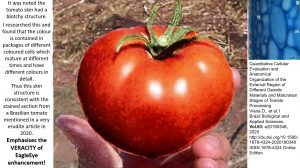Hi intrepid geoscientists!
I’ve had over 10,000 visits to the Q&A session people been having on this TOMATO topic see ( North America video ( https://www.youtube.com/watch?v=MtzmRbDw73w ) and LinkedIn https://www.linkedin.com/in/bob-watchorn-97b95624/recent-activity/shares/ ).
Most of them would be geoscientists so it is important to make the following points to all those interested observers. Please read to end!

This enhancement was done in the correct scientific manner.
Because the image of the tomato has three different domains I separated these domains out and enhanced them separately. This should be standard scientific procedure!
What are immediately visible are the blotches on the skin of the tomato and the much better resolution and brightness of the thumb and background garden which I’ll discuss now.
We’ll first examine the tomato skin blotches on what looks like a nice glossy uniform skin in the original image.

It was noted the tomato skin had a blotchy colouring.
I researched this and found that the colour is contained in packages of different coloured cells which mature at different times and have different colours in detail (http://dx.doi.org/10.1590/1678-4324-2020190348 ISSN 1678-4324 Online Edition). See top right inset of a section of the skin and next layer which has been dyed blue to show the structure by the Brazilian researchers.
Thus this skin structure is consistent with the Brazilian tomato. I learnt something new!
This emphasises the VERACITY of EagleEye enhancement! If the biologists can do this enhancement then maybe geoscientists can copy them? This has been my objective all along – to bring the geoscience enhancement of structures up to the standard seen in the medical and other industries.
I don’t care what package is used or copied – MRI would be a great start on what we are now using.
Enough of that Bob 🙂 !!
Next the thumb was domained out and examined in detail.

The thumb now looks like a proper 3D thumb, even if the texture is that of an octogenarian!
It was difficult to get a good thumb enhancement with the strong magnification of the very dark fuzzy original image. The weak vertical and horizontal lines are from the original pixels of the colour distribution in the original image. Much more could be done with this enhancement but this is enough to get the picture (so to speak).
Note the different ‘structure’ of the skin under the tomato. Are these evidence of pressure point compression of the skin???
I did a bit of ‘background research’ and held a tomato in that position with a bit of pressure (as can be seen by the bulging of the thumb under the fingernail) and found my skin creased similarly to the curved lines down on the lower right.
The main comment to make is that these speculations can only be made when one has properly constructed, detailed images to view and discuss.
We will now examine the garden.

The original image (top) lacked detail and was grossly out of focus as the camera is focused on the tomato. This is similar to most of the geoscience images we work with – Landsat, Tomography, gravity Magnetics etc.
The lower EagleEye enhanced image is much clearer, shows more structure and has some ‘topography’, or a weak 3D effect.
The main thing to mote that despite the very poor original image that the enhanced image is correctly enhancing the structures and topography in their correct ‘morphology’ and geographical position.
So now to the crux of the ongoing discussion as to the veracity (or otherwise) of EagleEye.

There is a vast difference between the two enhancements even though we were both using my EagleEye system.
Picasso would be proud of Tobias’s creation but mine (as i have explained above) is true to the original data and has even enabled me to find out a lot about how the tomato skin is coloured.
Tobias did not recognise that domaining out the three domains is critical. He did not domain and treatg each domain differently. Recognising the characteristics of each domain and separating them is basic structural geology 101.
If you don’t domain all the structures get mixed up and you can’t tell which ones belong where! That’s the whole basis of a deformation sequence D1, D2 etc. If you don’t domain you can’t get one!
A geoscientist’s training plays a huge part in using tools correctly. I don’t hold Tobias responsible for that, it’s not his fault, for as a geochemist he has probably had little structural geology training (I may be wrong?).
Unfortunately the old saying of rubbish in rubbish out (RIRO) still applies to Tobias’s EagleEye enhancement.
The worrying aspect of the whole discussion has been that Tobias will not admit that his EagleEye enhancement is rubbish.
Tobias (although an excellent geochemist) on the basis of his ‘enhancement’ has systematically denigrated my structural geology work. I wouldn’t mind this if he had used a good technical/scientific basis to argue it on. Not so.
However the whole interesting discussion has galvanised me to do what Tobias and many others have rightly suggested over the last 20 years –
1. Do a paper on the background software used and operating procedures of the EagleEye system.
2. Give watertight examples of structures EagleEye has defined in the paper.
2. Get that paper peer reviewed.
3. Publish the paper.
Conclusion. This latest post was very interesting to do and I learnt a lot about tomatoes!!
I guess that’s what it’s all about – learning.
I’ve had over 10K visits to the Q&A session people been having on this TOMATO topic. Most of them would be geoscientists so it is important to make the following point to all those interested observers.
EAGLE-EYE IS A VERIFIABLE SYSTEM THAT CAN BE USED IN GEOSCIENCE (AND MAYBE HORTICULTURE) FOR ALL OUR BENEFIT!!!
Cheers
Bob

